Volume 5, Number 34 | August 24-30, 2006
Gallery
Freeing the Line
Marian Goodman Gallery
24 W 57th St.
Mon.-Fri. 10 a.m.-6 p.m.
Through Aug. 26
212-977-7160
Free Time
Whimsical and richly rewarding summer show
he art world mirrors the academic schedule in that during the summer, they’re out. Cast aside are the rigors of September through June and an emphasis on solo exhibitions of stable artists.
“Freeing the Line,” curated by the Drawing Center’s ex-director, Catherine de Zegher, is a whimsical, but richly rewarding example of a summer show, juxtaposing older examples with some contemporary ones in a survey of the humble line liberated from traditional media.
The artworks in the entry gallery of “Freeing the Line” are so airy that, at first glance, the room feels empty. After the eye searches for a few moments, wiry images come into focus––GEGO (Gertrude Goldschmidt), assembled floating geometric shapes formed of clasped metal segments evoking a very elaborate child’s or idle office worker’s paper clip necklace. Two other GEGO constructions hang against the wall—one made of Meccano parts, the other, bits of metal and wire. Richard Tuttle’s elemental 1972 work of intersecting lines composed of nails and wire floats off of another wall. Karel Malich’s poetic wire mobiles dangle nearby; their loose arrangements seem less concerned with physical description than the titles (“Energy I,” “Landscape II,” “Tree”).
Some individual works of Joelle Tuerlinckx’s “Volume of Air” series of cubes of white-clad iron, come with hefty monikers that seem to beg being read aloud, such as “Volume of Air + blue + pink + European neutral grey, American neutral grey;” others end with men’s names. Shades of color peek from under white overlayers of plaster, tipex, and thread. Tuerlinckx also created a room installation (“Room of Volume of Air – 13 Elements”) of such cube and rectangular “volumes” with additional linear elements of wood, plastic, etc., laid casually on top. In the south gallery, she has arrayed a number of pieces atop a worktable, each a twist on linear representation, from rolls of toilet paper or tracing paper to lengths of plexi with magic marker lines scrawled upon them.
Ranjani Shettar’s “Vasanta (Spring/ Transition)” occupies a small room. A marvelous macramé-like spiral made of tea-dyed string netting held together with multi-colored wax nodules, it is both delicate and commanding. Julie Mehretu hews to the more traditional ink and acrylic on canvas, in one example overlaying an X/Y grid with blustery cross-hatchings that resemble a storm system, and darting red vertical lines. Eva Hesse’s two untitled sculptures are simple – tubing and lozenge shapes hang from the wall—but have a genial, winking presence.
“Transition,” by Monika Grzymala, makes a powerful statement about how repeating lines can accumulate into a solid plane. Using 8.3 kilometers of masking tape, she has swarmed a corner of the gallery, layering lengths on the wall, across a window, cutting a corner diagonally, encircling a column, and flowing onto the floor. Like a human-made spider web, the repeated accretion of a fine substance gains many times its solo strength.
gaycitynews.com

































